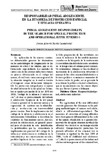Mostrar el registro sencillo del ítem
Responsabilidad penal adolescente, en la búsqueda de protección especial y eficacia operativa
| dc.rights.license | http://creativecommons.org/licenses/by-nc-sa/3.0/ve/ | es_VE |
| dc.contributor.author | Rubio Castañeda, Jesús Alberto | |
| dc.date.accessioned | 2018-06-20T21:18:30Z | |
| dc.date.available | 2018-06-20T21:18:30Z | |
| dc.date.issued | 2017 | |
| dc.identifier.issn | 1690-3544 | |
| dc.identifier.uri | http://www.saber.ula.ve/handle/123456789/45018 | |
| dc.description.abstract | La aplicación de las nuevas corrientes diferenciales generan las disyuntivas en las metodologías de juzgamiento de los menores de edad y los adultos, que es diferenciada-especializada. Las medidas de corrección de los jóvenes infractores tienen su génesis diferenciada en el código del menor, el cual tenía como marco general de la situación irregular en la cual se trataba al trasgresor como delincuente inimputable. La protección integral para el menor de edad infractor de la ley penal en Colombia se tipifica por medio de la ley 1098 del 2006, “código de la infancia y adolescencia”, el cual es proteccionista del infante y adolescente trasgresor de la ley penal, el marco general de la anterior norma y la exposición de motivos son la rehabilitación y reeducación con transversalidad proteccionista. Para la implementación del código de la infancia y adolescencia en el ordenamiento Colombiano se describen las calidades de funcionarios jueces, fiscales, policía de adolescencia, en general personal para el ejercicio de esta jurisdicción. La problemática que ha demostrado la implementación procesal del código de la infancia y adolescencia se evidencia en la reincidencia y sus consecuencias sociales, posibles hipótesis de las causas son: tanto la falta preparación de los servidores, así como la ineficacia de los establecimientos cerrados en la búsqueda de la reeducación y resocialización del adolescente encartado en la trasgresión al sistema penal sustantivo colombiano. Aunque es una realidad el incremento de la adolescencia infractora el manejo de las cifras criminalidad obedece a factores político –económicos emanados de factores reales de poder, así se presenta la reacción en la política criminal colombiana, que es inconsistente con las causas objetivas que llevan al joven a delinquir. | es_VE |
| dc.language.iso | es | es_VE |
| dc.publisher | SABER-ULA | es_VE |
| dc.rights | info:eu-repo/semantics/openAccess | es_VE |
| dc.subject | Responsabilidad penal | es_VE |
| dc.subject | Adolescente infractor | es_VE |
| dc.title | Responsabilidad penal adolescente, en la búsqueda de protección especial y eficacia operativa | es_VE |
| dc.title.alternative | Penal adolescent responsibility, in the search for special protection and operational effectiveness | es_VE |
| dc.type | info:eu-repo/semantics/article | es_VE |
| dcterms.dateAccepted | 02/08/2017 | |
| dcterms.dateSubmitted | 29/06/2017 | |
| dc.description.abstract1 | The application of the new differential currents generates the dilemmas in the judging methodologies of minors and adults, which is differentiated-specialized. The measures of correction of young offenders have their genesis differentiated in the code of the minor, which had as a general framework the irregular situation in which the offender was treated as an unimpeachable offender. Comprehensive protection for juvenile offenders of the criminal law in Colombia is typified by the law 1098 of 2006, “code of childhood and adolescence”, which is protectionist of the infant and adolescent transgressor of the criminal law, the The general framework of the previous norm and the explanatory statement are rehabilitation and reeducation with protectionist transversality. For the implementation of the code of childhood and adolescence in the Colombian legal system, the qualities of civil servants judges, prosecutors, adolescent police officers, and in general personnel for the exercise of this jurisdiction are described. The problematic that has demonstrated the procedural implementation of the code of the childhood and adolescence is evident in the recidivism and its social consequences, possible hypotheses of the causes are: as much the lack preparation of the servants, as well as the inefficiency of the closed establishments in the search of the reeducation and re-socialization of the adolescent involved in the transgression of the Colombian substantive criminal system. Although the increase in delinquent adolescence is a reality, the management of crime figures obeys to political-economic factors emanating from real factors of power, this is the reaction in Colombian criminal policy, which is inconsistent with the objective causes that lead to the young to commit a crime. | es_VE |
| dc.description.colacion | 634-653 | es_VE |
| dc.description.email | maestria.ddhh@uptc.edu.co | es_VE |
| dc.description.frecuencia | Anual | |
| dc.identifier.depositolegal | 2002TA1412 | |
| dc.publisher.pais | Venezuela | es_VE |
| dc.subject.facultad | Núcleo Táchira (NUTULA) | es_VE |
| dc.subject.keywords | Criminal responsibility | es_VE |
| dc.subject.keywords | Adolescent offender | es_VE |
| dc.subject.seccion | Heurística: Experiencias Humanitarias | es_VE |
| dc.subject.thematiccategory | Ciencias Económicas y Sociales | es_VE |
| dc.subject.tipo | Revistas | es_VE |
| dc.subject.unidadinv | Grupo de Investigación de Historia de la Educación y Representaciones (HEDURE) | es_VE |
| dc.type.media | Texto | es_VE |
Ficheros en el ítem
Este ítem aparece en la(s) siguiente(s) colección(ones)
-
Heurística - Número 020
enero - diciembre 2017


